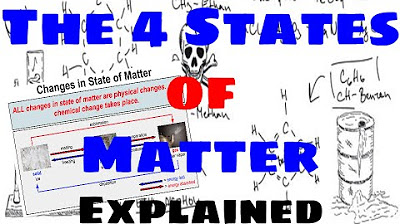Topnienie, krzepnięcie, parowanie, skraplanie #4 [ Zjawiska cieplne ]
Summary
TLDRIn this educational video, the fascinating processes of phase transitions are explored, from melting and freezing to evaporation and condensation. Through a hands-on experiment, the script demonstrates how ice melts at 0°C without the temperature rising until it has completely transitioned to water. It explains how energy is used to break molecular bonds during these changes. The video also delves into concepts like boiling and condensation, using examples like water on a stove and breath on a cold window. Overall, the lesson provides an insightful explanation of physical changes in matter, from solid to liquid to gas, in an engaging and accessible way.
Takeaways
- 😀 Ice does not melt immediately when it reaches 0°C because energy is first used to break molecular bonds before the temperature rises.
- 😀 The melting process is due to the crystalline structure of ice, where water molecules are rigidly organized and need energy to break free.
- 😀 As ice melts, its temperature stays at 0°C until all the ice has turned into liquid water.
- 😀 The process of freezing (solidification) involves molecules losing energy, moving slower, and forming a solid structure.
- 😀 Liquids can turn into gases through evaporation, which occurs at any temperature but intensifies closer to the boiling point.
- 😀 Boiling is a type of evaporation that occurs throughout the entire liquid when it reaches its boiling point (100°C for water).
- 😀 During boiling, all the heat added goes into turning liquid into gas, rather than increasing temperature.
- 😀 Water molecules have strong dipole interactions, making them harder to break apart, thus requiring more energy to boil.
- 😀 When a gas turns into a liquid, energy is released, and molecules move closer, forming a liquid, a process known as condensation.
- 😀 Changes in states of matter (phase transitions) occur without changing the temperature, and all the energy goes into altering the state of the substance.
- 😀 The temperature at which a substance changes state is called the phase transition temperature, and each transition requires energy input or release.
Q & A
Why does ice not immediately melt when the temperature exceeds 0°C?
-Ice does not immediately melt because, although the temperature exceeds 0°C, the energy supplied is initially used to break the bonds between the water molecules in the ice. Only after the ice has fully melted does the temperature start to increase.
What happens to the temperature of ice as it melts?
-The temperature of the ice remains close to 0°C during the melting process because the energy being supplied is used to break the crystalline bonds between water molecules, rather than increasing the temperature.
Why does it require energy to melt ice?
-Melting ice requires energy to overcome the bonds between the water molecules in the ice. This energy is used to break the crystalline structure, allowing the molecules to move more freely and transition to the liquid state.
What is the key difference between the melting of ice and the heating of water after it melts?
-The key difference is that during the melting of ice, energy is used to break the crystalline bonds, and the temperature does not rise until the ice has fully melted. After the ice turns into water, additional energy increases the temperature of the liquid.
How does the freezing process work?
-During freezing, a liquid loses energy to its surroundings, causing its molecules to slow down and form ordered structures, such as crystals. The temperature of the liquid only decreases after it has completely solidified.
What is the difference between evaporation and boiling?
-Evaporation occurs at the surface of a liquid and can happen at any temperature, while boiling occurs throughout the entire volume of the liquid at its boiling point, creating bubbles of gas.
What happens during the boiling process?
-During boiling, the temperature of the liquid does not rise beyond the boiling point because the energy is used to break the bonds between the liquid molecules and convert them into vapor. This continues until the entire liquid has turned into gas.
What is meant by 'temperature of phase transition'?
-The 'temperature of phase transition' refers to the temperature at which a substance changes from one state of matter to another, such as from solid to liquid (melting) or liquid to gas (boiling). This is where the substance absorbs or releases energy without changing temperature.
What happens when gas condenses into a liquid?
-When gas condenses into a liquid, it loses energy to its surroundings, causing the molecules to slow down. As they move closer together, the gas molecules form a liquid state, which can be observed as droplets on a cold surface.
How do dipoles affect the boiling point of water?
-Dipoles in water molecules create strong intermolecular forces of attraction. These forces make it harder for the molecules to escape into the gas phase, resulting in a high boiling point for water compared to many other liquids.
Outlines

This section is available to paid users only. Please upgrade to access this part.
Upgrade NowMindmap

This section is available to paid users only. Please upgrade to access this part.
Upgrade NowKeywords

This section is available to paid users only. Please upgrade to access this part.
Upgrade NowHighlights

This section is available to paid users only. Please upgrade to access this part.
Upgrade NowTranscripts

This section is available to paid users only. Please upgrade to access this part.
Upgrade NowBrowse More Related Video

Wujud Zat dan Perubahannya | IPAS Kelas 4 Kurikulum Merdeka

SCIENCE 7: Quarter 1-LC 5: PHASE CHANGES OF THE STATES OF MATTER| MATATAG CURRICULUM

The Four States of Matter - Explained

Wujud Zat, Bentuk Partikel dan Sifatnya

KALOR DAN PERUBAHAN WUJUD | KALOR DAN PERPINDAHAN KALOR

Science 8 - Quarter 3 Week 3-4 | Phase Changes
5.0 / 5 (0 votes)